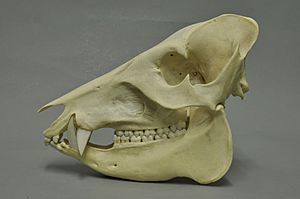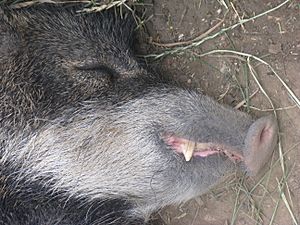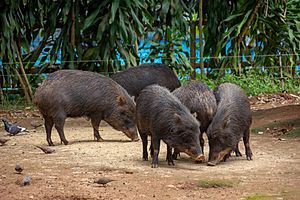White-lipped peccary facts for kids
Quick facts for kids White-lipped peccary |
|
|---|---|
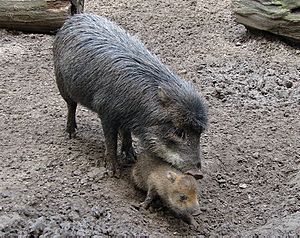 |
|
| Conservation status | |
| Scientific classification | |
| Genus: |
Tayassu
|
| Species: |
pecari
|
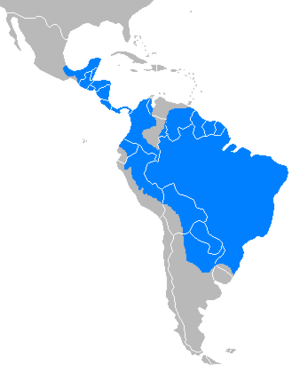 |
|
| Range of the white-lipped peccary (note that the Central American part of its range is much more fragmented in actuality and that its presence in El Salvador is erroneous) | |
| Synonyms | |
|
|
The white-lipped peccary (Tayassu pecari) is a pig-like animal found in Central and South America. It is the only member of its group, called Tayassu. There are five different types, or subspecies, of white-lipped peccaries.
These animals look a lot like pigs, but they are covered in dark hair. Only parts of their body, like their throat, are a creamy white color. White-lipped peccaries live in an area stretching from Mexico all the way to Argentina. However, their habitat is now broken up, and their numbers are going down, especially in Mexico and Central America.
You can find them in many different kinds of homes, like dense forests. White-lipped peccaries are very social and usually look for food in large groups. These groups can have as many as 300 peccaries! They are an important part of their ecosystem, and many people are working to protect them.
Not all disappearances are fully understood, but human actions play a big role. Two main threats are deforestation (cutting down forests) and hunting. Hunting is common in rural areas. However, hunting white-lipped peccaries can be dangerous because they can be quite fierce. People hunt them for their skin and meat.
Contents
About the White-Lipped Peccary
The white-lipped peccary was first described in 1795 by Johann Heinrich Friedrich Link. He first called it Sus pecari. Later, in 1814, Gotthelf Fischer von Waldheim moved it into its own special group, Tayassu.
Different Types of White-Lipped Peccaries
There are five types of white-lipped peccaries that scientists recognize:
- T. p. pecari
- T. p. aequatoris
- T. p. albirostris
- T. p. ringens
- T. p. spiradens
How White-Lipped Peccaries Have Changed Over Time
We don't have many fossils of the white-lipped peccary. But we know they have been around since at least the Pliocene era. Fossils from the Late Pleistocene suggest they lived in different places back then, mostly in more southern areas like Argentina.
White-Lipped Peccary Hybrids
White-lipped peccaries can have babies with another type of peccary called the collared peccary (Dicotyles tajacu). This has only happened in zoos, like the London Zoo and Manaus Zoo, never in the wild.
What Does a White-Lipped Peccary Look Like?
The white-lipped peccary is an animal that looks like a pig. It has dark hair all over its body, but its throat and belly areas are a creamy white color. Adult white-lipped peccaries can grow to be about 90 to 135 centimeters (35 to 53 inches) long. They stand about 90 centimeters (35 inches) tall at the shoulder.
They usually weigh between 27 and 40 kilograms (60 to 88 pounds), but some can be even heavier. It's hard to tell males and females apart just by looking, but males have longer canine teeth (tusks) than females. They also have a special scent gland on their back, which they use to mark their territory.
Where White-Lipped Peccaries Live and Their Homes
White-lipped peccaries live in many countries, including Argentina, Belize, Bolivia, Brazil, Colombia, Costa Rica, Ecuador, French Guiana, Guatemala, Guyana, Honduras, Mexico, Nicaragua, Panama, Paraguay, Peru, Suriname, and Venezuela. Sadly, they no longer live in El Salvador.
They love living in thick, wet, tropical forests. But they can also be found in other places like dry forests, grasslands, mangroves, and dry areas with tough plants. They can live from sea level up to about 1,900 meters (6,200 feet) high. Their home areas often overlap with those of the collared peccary.
A study in 2018 found that white-lipped peccaries had disappeared from 87% of their old homes in Central America. They are now in "critical condition" in the seven Central American countries where they still live. Other studies show similar declines, like an 89% drop in Costa Rica and an 84% drop in Mexico and Guatemala.
How White-Lipped Peccaries Behave and Live
White-lipped peccaries usually travel in large groups. Unlike collared peccaries, which walk in a single line, white-lipped peccaries move in wide groups. These groups can have as few as five animals or as many as 300. Very large groups are less common now because there are fewer peccaries overall.
In one area of the Atlantic Forest, the average group size was about 42. These groups often meet each other and mix. Young peccaries usually make up no more than 20% of a herd.
White-lipped peccaries and collared peccaries often live in the same areas. A study in 1982 found that white-lipped peccaries have a bite force at least 1.3 times stronger than collared peccaries. This might help explain how they can live together. The study also found that they eat different kinds of seeds and nuts when they are in the same area.
White-lipped peccaries can make loud screaming noises and clack their teeth when they travel. This helps them stay together and scares away animals that might try to hunt them. They also make low barking, growling, moaning, and high-pitched squealing sounds.
What White-Lipped Peccaries Eat
White-lipped peccaries search for food, often near coastal areas or other bodies of water. Most of their diet is made up of fruit. But they also eat other parts of plants (like nuts), fungi, and small creatures like snails. Sometimes, they even eat fish. They eat over 140 different kinds of plants. Less often, they eat earthworms, eggs, small animals, and dead animals (carrion).
Who Hunts White-Lipped Peccaries?
White-lipped peccaries are an important food source for large feline predators like jaguars. When they are in big groups, they can scare away jaguars with their loud noises.
White-Lipped Peccary Reproduction and Life Cycle
White-lipped peccaries can have babies all year round. The female's estrus cycle (when she can get pregnant) usually lasts about 18 to 21 days. After being pregnant for about 158 days, she usually gives birth to two young. The baby peccaries can move with the rest of the group just a few hours after they are born.
Protecting White-Lipped Peccaries
The International Union for Conservation of Nature (IUCN) lists the white-lipped peccary as a vulnerable animal. This means their population is decreasing, even with efforts to protect them. They are also listed on Appendix II of CITES, which helps control their trade.
Dangers to White-Lipped Peccaries
White-lipped peccaries face many dangers. They need a lot of space, so deforestation (cutting down forests) is a big threat to them. They rely heavily on protected areas to keep their homes safe from human activities. When their habitat gets broken up, they are more likely to be hunted by people. Because they travel in large groups, they are easy to spot, and hunters can kill many at once. Even a little hunting can be a problem in areas where there aren't many peccaries.
In some parts of Brazil, healthy populations have completely disappeared. Their numbers have dropped by about 30% in the last 18 years, and this trend is expected to continue. Some disappearances are not explained and might be caused by disease.
Efforts to Help White-Lipped Peccaries
White-lipped peccaries already live in several protected areas, like the Güisayote Biological Reserve in Honduras and Manú National Park in Peru. However, these areas alone might not be enough to save them in all the places they naturally live. The IUCN has suggested new rules from CITES to limit the trade of their skins and pelts.
More research on their population has been done recently, but there are still areas that need more study. Peru is very active in trading peccary hides, which are made into shoes and gloves for European businesses. But the Wildlife Conservation Society (WCS) has been working in Peru since 1980 to make sure hunting is done in a way that doesn't harm the peccary population, and they also monitor the animals.
White-Lipped Peccaries and People
White-lipped peccaries are often hunted by both local people and others living in their habitat. Their meat is described as "white" and "plentiful" by the Food and Agriculture Organization of the United Nations (FAO). It is sold and eaten in rural communities, where peccaries are important game animals.
Even though they are easy to find because they are loud and travel in herds, white-lipped peccaries can be dangerous to hunt. They are known to kill dogs, and people usually hunt them in groups. They tend to stand their ground when attacked, so many can be killed before the group runs away. Their scent gland is usually removed right after they are killed so it doesn't affect the taste of their meat. In Peru, people are allowed to hunt them for food in towns with fewer than 3,000 people.
Images for kids
See also
 In Spanish: Pecarí barbiblanco para niños
In Spanish: Pecarí barbiblanco para niños



